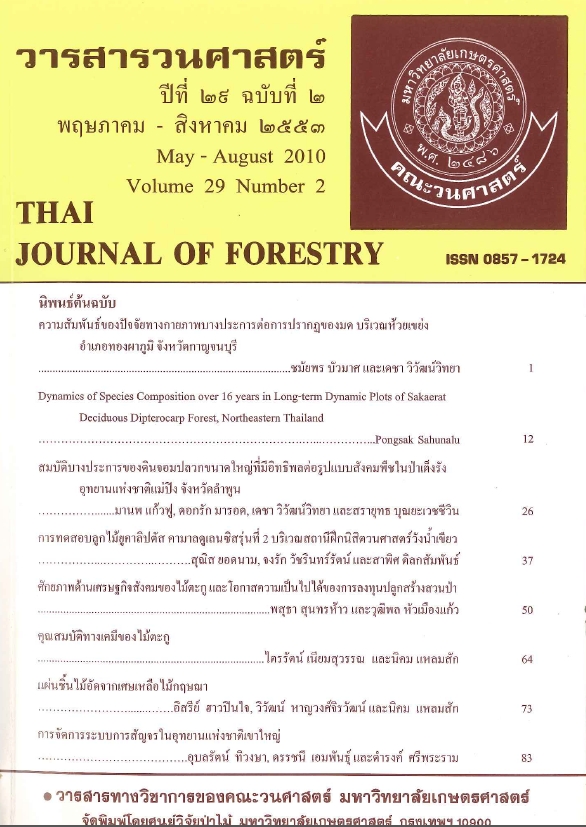ศักยภาพด้านเศรษฐกิจสังคมของไม้ตะกู และโอกาสความเป็นไปได้ ของการลงทุนปลูกสร้างสวนป่า
Main Article Content
บทคัดย่อ
ศักยภาพด้านเศรษฐกิจสังคมของไม้ตะกูและโอกาสความเป็นไปได้ของการลงทุนปลูกสร้างสวนป่า มีวัตถุประสงค์ เพื่อศึกษาสถานภาพปัจจุบันของระบบการผลิตและครรลองการตลาด ผลตอบแทนด้านการเงิน โอกาสความเป็นไปได้ของการลงทุน และความอ่อนไหวของการปลูกสร้างสวนป่าไม้ตะกู ทั้งนี้ได้เน้นธุรกิจต่างๆ ที่เกี่ยวข้องกับไม้ตะกู ตั้งแต่แหล่งผลิตเมล็ดพันธุ์และกล้าไม้ การค้าส่งและค้าปลีกกล้าไม้ สวนป่าไม้ตะกู แหล่งรับซื้อไม้ตะกู โรงงานประดิษฐกรรมไม้ และผู้ใช้ผลิตภัณฑ์ ที่กระจายอยู่ในทุกภูมิภาคของประเทศ ซึ่งการศึกษาได้มีการสุ่มตัวอย่างแบบจำแนกชั้นตามลักษณะของแต่ละประเภทธุรกิจ
ผลการศึกษา พบว่า ไม้ตะกูได้ถูกตั้งชื่อทางการค้ามากมาย เช่น “ไม้ตะกูยักษ์” “ไม้ตะกูใหญ่” “ไม้ตุ้มหลวง” “ไม้สักเขียว” “ไม้มหาเศรษฐี” เพื่อการโฆษณาในหลากหลายรูปแบบอย่างเป็นรูปธรรมตั้งแต่ต้น ปี พ.ศ. 2550 โดยเฉพาะการติดป้ายโฆษณาขายกล้าไม้ตามริมสองข้างถนน และการโฆษณาผ่านเครือข่ายอินเทอร์เน็ต ในขณะนี้พบว่ามีเกษตรกร 12,318 คน ได้ดำเนินการปลูกไปแล้วในพื้นที่ 32,473 ไร่ และคิดเป็นมูลค่าเงินหมุนเวียนที่เกิดขึ้นจากการลงทุนประมาณ 533 ล้านบาท โดยพบว่าผู้ที่ดำเนินธุรกิจเกี่ยวกับไม้ตะกูเป็นผู้ที่มีการศึกษาและฐานะทางการเงินดี ในส่วนของระบบการผลิตและครรลองการตลาดพบว่า แหล่งผลิตเมล็ดพันธุ์ไม้และกล้าไม้รวมทั้งสวนป่าไม้ มีการกระจายครอบคลุมทุกภูมิภาคของประเทศ โดยเมล็ดไม้ตะกูส่วนใหญ่มีแหล่งกำเนิดมาจากทางภาคเหนือของประเทศ ส่วนการปลูกสร้างสวนป่ามีการดำเนินการอยู่ในภาคตะวันออกเฉียงเหนือมากที่สุด แต่ทั้งนี้ระบบยังขาดความชัดเจนในส่วนของผู้รับซื้อไม้และโรงงานประดิษฐกรรมไม้ สำหรับผลตอบแทนด้านการเงินจากการปลูกสร้างสวนป่าไม้ตะกู โดยการคำนวณมูลค่าปัจจุบันสุทธิ (net present value, NPV) และอัตราส่วนผลประโยชน์ต้นทุน (B/C ratio) ที่ระดับอัตราดอกเบี้ยร้อยละ 6 และกำหนดรอบตัดฟันเท่ากับ 5 ปี พบว่าประสบกับปัญหาการขาดทุนในทุกระดับราคาไม้ท่อนตะกูที่ต่ำกว่า 1,734 บาท/ตัน ซึ่งเป็นราคาที่ทำให้เกิดจุดคุ้มทุน (break-even point) ส่วนโอกาสด้านการลงทุน พบว่า ยังให้ผลตอบแทนต่ำที่สุดเมื่อเปรียบกับพืชเศรษฐกิจ 5 ชนิด ได้แก่ ข้าวโพดเลี้ยงสัตว์ ไม้ยางพารา อ้อย มันสำปะหลัง และไม้ยูคาลิปตัส และจากการวิเคราะห์ความอ่อนไหวของการปลูกสร้างสวนป่าไม้ตะกู พบว่า เมื่อราคากล้าไม้เท่ากับ 1 บาท/ต้น ซึ่งถือว่าเป็นราคาต่ำสุดที่เป็นไปได้ ราคารับซื้อไม้ท่อนอย่างน้อยต้องเท่ากับหรือมากกว่า 800 บาท/ตัน ถึงจะเหมาะสมสำหรับการลงทุน
คำสำคัญ: ไม้ตะกู ศักยภาพด้านเศรษฐกิจสังคม ระบบการผลิต ครรลองการตลาด การลงทุนปลูกสร้างสวนป่า
Downloads
Article Details

อนุญาตภายใต้เงื่อนไข Creative Commons Attribution-NonCommercial-NoDerivatives 4.0 International License.
ข้าพเจ้าและผู้เขียนร่วม (ถ้ามี) ขอรับรองว่า ต้นฉบับที่เสนอมานี้ยังไม่เคยได้รับการตีพิมพ์และไม่ได้อยู่ในระหว่างกระบวนการพิจารณาตีพิมพ์ลงในวารสารหรือสิ่งตีพิมพ์อื่นใด ข้าพเจ้าและผู้เขียนร่วม (ถ้ามี) ยอมรับหลักเกณฑ์และเงื่อนไขการพิจารณาต้นฉบับ ทั้งยินยอมให้กองบรรณาธิการมีสิทธิ์พิจารณาและตรวจแก้ต้นฉบับได้ตามที่เห็นสมควร พร้อมนี้ขอมอบลิขสิทธิ์ผลงานที่ได้รับการตีพิมพ์ให้แก่วารสารวนศาสตร์ คณะวนศาสตร์ มหาวิทยาลัยเกษตรศาสตร์ กรณีมีการฟ้องร้องเรื่องการละเมิดลิขสิทธิ์เกี่ยวกับภาพ กราฟ ข้อความส่วนใดส่วนหนึ่ง หรือ ข้อคิดเห็นที่ปรากฏในผลงาน ให้เป็นความรับผิดชอบของข้าพเจ้าและผู้เขียนร่วม (ถ้ามี) แต่เพียงฝ่ายเดียว และหากข้าพเจ้าและผู้เขียนร่วม (ถ้ามี) ประสงค์ถอนบทความในระหว่างกระบวนการพิจารณาของทางวารสาร ข้าพเจ้าและผู้เขียนร่วม (ถ้ามี) ยินดีรับผิดชอบค่าใช้จ่ายทั้งหมดที่เกิดขึ้นในกระบวนการพิจารณาบทความนั้น”


